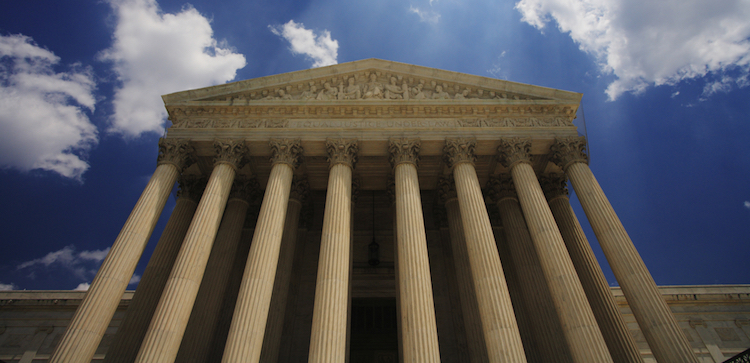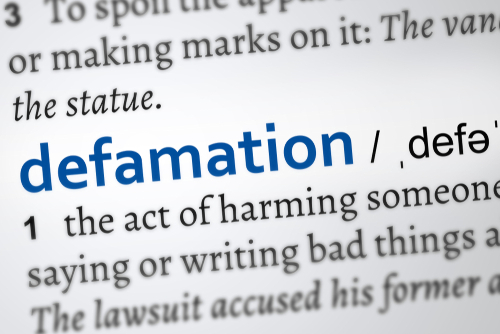Will the Supreme Court reconsider a landmark defamation case?

Image from Shutterstock.
The dissenting opinion was buried near the bottom of a busy orders list issued at the end of the U.S. Supreme Court term on July 2, but it has stirred tremors of concern among advocates for press freedom.
Justice Neil M. Gorsuch called for the reconsideration of New York Times Co. v. Sullivan, the landmark 1964 decision establishing that public officials suing for defamation must prove that an allegedly false statement was published with “actual malice”—that is, with knowledge that the disputed statement was false or with “reckless disregard” for whether it was false or not.
“Rules intended to ensure a robust debate over actions taken by high public officials carrying out the public’s business increasingly seem to leave even ordinary Americans without recourse for grievous defamation,” Gorsuch wrote.
The opinion was a dissent from denial of certiorari in Berisha v. Lawson, in which the high court declined to hear the appeal of an Albanian man who contends he was defamed by his portrayal in a 2015 book about three young men from Miami Beach who became international arms dealers.
Lower courts found that the Albanian, Shkelzën Berisha, was a limited public figure for the purposes of the controversy explored in the book. Thus, he could not recover without proving that the book’s author and other defendants had acted with actual malice, which those lower courts found he did not prove.
Justice Clarence Thomas wrote his own dissent from the cert denial in Berisha’s case, repeating themes he first expressed in a 2019 opinion that called for reconsidering Sullivan and the actual malice standard, at least as it applies to public figures, a category distinct from public officials.
“This court’s pronouncement that the First Amendment requires public figures to establish actual malice bears ‘no relation to the text, history, or structure of the Constitution,’” Thomas said in his Berisha dissent. He cited a dissent in another defamation case from earlier this year by Senior Judge Laurence H. Silberman of the U.S. Court of Appeals for the District of Columbia Circuit.
“New considerations have arisen over the last 50 years that make the New York Times decision … a threat to American democracy,” Silberman wrote. “It must go.”
The earlier opinion on Sullivan by Thomas, who frequently issues lone opinions that call for one precedent or another to be overruled, and Silberman, a sometimes-outspoken conservative on the D.C. Circuit, had been met with concern but not alarm among press advocates. But Gorsuch’s decision to sign on to their project to reconsider the landmark ruling caught them off guard.
“Seeing Gorsuch chime in with his dissent is giving First Amendment lawyers agita,” says Sarah Matthews, a senior staff attorney with the Reporters Committee for Freedom of the Press in D.C. (She quickly provided some synonyms for “agita”: anxiety and stress.)
“New York Times v. Sullivan is the rock of modern American press freedom,” she adds. “To have two Supreme Court justices call into question that decision and consider overruling it, that’s misguided.”
Floyd Abrams, a senior counsel at Cahill Gordon & Reindel in New York City and one of the nation’s top First Amendment advocates, says he views Sullivan as “the most significant majority opinion of the Supreme Court relating to freedom of the press in our history” and that “reversal of it would be a tragic step backwards.”
“We will have less important speech about people in power” if Sullivan is overruled, Abrams says. “That is a price we ought not to be willing to pay.”
 Image from Shutterstock.
Image from Shutterstock.
A full-page ad on civil rights
The Sullivan decision emerged from a time when segregationists in the South were suing newspapers and other news outlets for libel over their coverage of the civil rights movement. The New York Times was sued in Alabama not over one of its news articles but over a full-page advertisement by civil rights groups that detailed abuses by “Southern violators of the Constitution,” including police officers, to resist civil rights efforts.
L.B. Sullivan, a Montgomery, Alabama, city commissioner who oversaw the police, claimed that the ad’s charges referred to him, even though he was not named. And, he charged, several of the ad’s factual errors harmed his reputation. An Alabama jury took about two hours to rule for Sullivan and award him $500,000.
The Times faced potentially ruinous litigation by others, and it appealed to the Supreme Court. Justice William J. Brennan Jr. wrote the unanimous opinion for the court.
Later opinions extended the absolute malice standard in libel cases to lower-level public employees, widely known nongovernment employees defined as public figures, and candidates for public office.
Thomas, in his 2019 opinion dissenting from a cert denial in a case brought by one of Bill Cosby’s sexual assault accusers, said: “New York Times and the court’s decisions extending it were policy-driven decisions masquerading as constitutional law.”
In their opinions this month, both Thomas and Gorsuch struck themes that lies and misinformation in today’s media landscape reveal the need for stronger legal protections for the targets of such activity.
“Public figure or private, lies impose real harm,” Thomas said.
Gorsuch concentrated on the ways the media landscape has changed since 1964, when “comparatively large companies dominated the press, often employing legions of investigative reporters, editors and fact-checkers.”
But “thanks to revolutions in technology, today virtually anyone in this country can publish virtually anything for immediate consumption virtually anywhere in the world,” Gorsuch said. This has had some positives but has also led to the spread of “disinformation,” he said.
“In 1964, the court may have seen the actual malice standard as necessary ‘to ensure that dissenting or critical voices are not crowded out of public debate,’” Gorsuch added. “But if that justification had force in a world with comparatively few platforms for speech, it’s less obvious what force it has in a world in which everyone carries a soapbox in their hands.”
Gorsuch also outlined the difficulty that libel plaintiffs have at prevailing under the actual malice standard.
“Not only has the [Sullivan] doctrine evolved into a subsidy for published falsehoods on a scale no one could have foreseen, it has come to leave far more people without redress than anyone could have predicted,” he said.
‘A miasma of misinformation’
Gorsuch repeatedly cited a 2020 article in the Ohio State Law Journal by David A. Logan, a law professor at Roger Williams University in Bristol, Rhode Island. That article begins, “Our democracy is in trouble, awash in an unprecedented number of lies.”
“The court’s constraints on defamation law have facilitated a miasma of misinformation that harms democracy,” Logan said in an interview, adding that he sent his lengthy article to Thomas, who didn’t cite it but perhaps passed it to Gorsuch.
Logan says it is perfectly reasonable to start a conversation about Sullivan and its progeny, especially with regard to lower-level public employees and public figures.
“Even very low-level public employees are burdened with the same high proof requirements as a governor or the president,” he says.
RonNell Andersen Jones, a law professor and First Amendment scholar at the University of Utah, says that while misinformation on the internet is a serious problem, tinkering with a press freedom landmark does not seem to be the right way to address it.
“We’re barking up the wrong tree here,” says Jones. “To be sure, these sweeping, harmful lies that spread on the internet are increasingly problematic. But the Sullivan standard, and defamation law more broadly, may be not the most sensible tool for dealing with this. The worry here might be that reconsidering Sullivan creates a vulnerability for those entities that are attempting to maintain reputations for responsible newsgathering.”
Jones and Sonja West of the University of Georgia Law School co-authored a recent analysis of references to the press by the Supreme Court going back to 1784. The study found that in recent years, there has been a “stark deterioration” of the quantity and quality of the court’s discussions of press freedom in opinions and other settings.
“The current court seems to have soured on the press and is disinclined to recognize the freedom of the press,” Jones says.
Matthews of the Reporters Committee says the Supreme Court has not granted full review of a press freedom case in 20 years. The court has not gotten the four votes needed to take up the issue of reconsidering Sullivan, but the opinions by Thomas and Gorsuch send a signal to litigants to keep trying, she says.
“Just seeing that this idea is gaining a little steam is very disturbing,” Matthews says.
Write a letter to the editor, share a story tip or update, or report an error.


